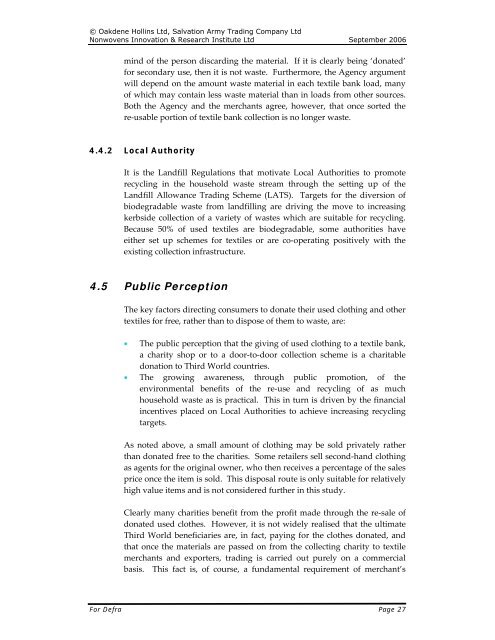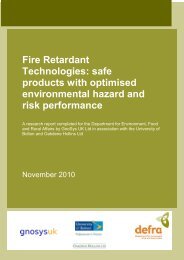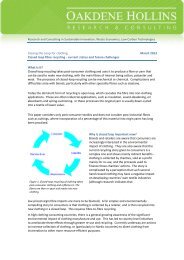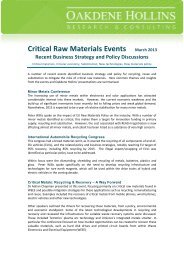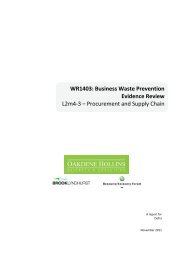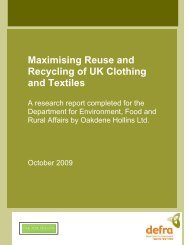Recycling of Low Grade Clothing Waste - Oakdene Hollins
Recycling of Low Grade Clothing Waste - Oakdene Hollins
Recycling of Low Grade Clothing Waste - Oakdene Hollins
Create successful ePaper yourself
Turn your PDF publications into a flip-book with our unique Google optimized e-Paper software.
© <strong>Oakdene</strong> <strong>Hollins</strong> Ltd, Salvation Army Trading Company Ltd<br />
Nonwovens Innovation & Research Institute Ltd September 2006<br />
mind <strong>of</strong> the person discarding the material. If it is clearly being ‘donated’<br />
for secondary use, then it is not waste. Furthermore, the Agency argument<br />
will depend on the amount waste material in each textile bank load, many<br />
<strong>of</strong> which may contain less waste material than in loads from other sources.<br />
Both the Agency and the merchants agree, however, that once sorted the<br />
re‐usable portion <strong>of</strong> textile bank collection is no longer waste.<br />
4.4.2 Local Authority<br />
It is the Landfill Regulations that motivate Local Authorities to promote<br />
recycling in the household waste stream through the setting up <strong>of</strong> the<br />
Landfill Allowance Trading Scheme (LATS). Targets for the diversion <strong>of</strong><br />
biodegradable waste from landfilling are driving the move to increasing<br />
kerbside collection <strong>of</strong> a variety <strong>of</strong> wastes which are suitable for recycling.<br />
Because 50% <strong>of</strong> used textiles are biodegradable, some authorities have<br />
either set up schemes for textiles or are co‐operating positively with the<br />
existing collection infrastructure.<br />
4.5 Public Perception<br />
The key factors directing consumers to donate their used clothing and other<br />
textiles for free, rather than to dispose <strong>of</strong> them to waste, are:<br />
• The public perception that the giving <strong>of</strong> used clothing to a textile bank,<br />
a charity shop or to a door‐to‐door collection scheme is a charitable<br />
donation to Third World countries.<br />
• The growing awareness, through public promotion, <strong>of</strong> the<br />
environmental benefits <strong>of</strong> the re‐use and recycling <strong>of</strong> as much<br />
household waste as is practical. This in turn is driven by the financial<br />
incentives placed on Local Authorities to achieve increasing recycling<br />
targets.<br />
As noted above, a small amount <strong>of</strong> clothing may be sold privately rather<br />
than donated free to the charities. Some retailers sell second‐hand clothing<br />
as agents for the original owner, who then receives a percentage <strong>of</strong> the sales<br />
price once the item is sold. This disposal route is only suitable for relatively<br />
high value items and is not considered further in this study.<br />
Clearly many charities benefit from the pr<strong>of</strong>it made through the re‐sale <strong>of</strong><br />
donated used clothes. However, it is not widely realised that the ultimate<br />
Third World beneficiaries are, in fact, paying for the clothes donated, and<br />
that once the materials are passed on from the collecting charity to textile<br />
merchants and exporters, trading is carried out purely on a commercial<br />
basis. This fact is, <strong>of</strong> course, a fundamental requirement <strong>of</strong> merchant’s<br />
For Defra Page 27


